I'm overdue for a PFJ update. Even us geezer OAPs find ourselves with too much on the plate. At least, I have progress to report instead of my usual endless questions. Onwards to lotsa verbiage.....
The 1/2” British Standard Pipe fitting for the 12-vane water pump cover that I had been hyperventilating about finally showed up. I found a US company on eBay that supplied it:
===>
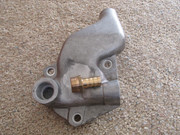
The new water pump cover together with the serious looking 12-vane water pump supplied by the Bros Rimmer offered an impressive piece of kit:
===>
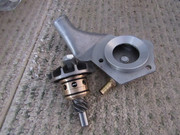
I was indeed fortunate (from what I have read) to have the old leaking 6-vane water pump jump right out of the block upon my rotating that LH thread bolt, and the new 12-vane water pump just rotated back into place with little effort on my part. Oh, my – such shiny vane surfaces:
===>
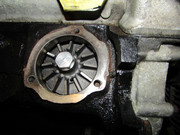
The fitting process for the new pump cover was a bit of a rigmarole. For me the biggest PITA was the measurement of the free gap between the pump cover and the block. I spent LOTS of time with feeler gauges to try and get a consistent gap measurement around the perimeter of the cover. Then it dawned on me that to this *precision* measurement, one adds anywhere between 0.0125" - 0.0250" (with no advice given on where one should aim for in this spread), so the overall accuracy required must be rather loose. I ended up using the single 0.030" gasket for the install. So new pump, cover, hoses and clamps were all finally in place:
===>
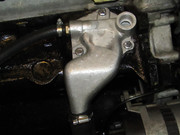
Next was the high stress process of refitting the entire intake manifold assembly, as well as the bypass tube designed (probably) by a sociopath. I have already chewed all that over on a different TDC Forum thread (see page 2 there), so no need to repeat all that here. For the link there:
https://forum.triumphdolomite.co.uk/vie ... 2&start=15
Finally that intake assembly and all of its various connections and plumbing were in place. Time to do a “hydrostatic” leak test (just fill the cooling system, let it sit there quietly for several hours to see if any coolant is seeping out anywhere). And of course, it was seeping...in two spots. Fig compote! First, of course, the one and only hose that I had not replaced with a new hose was dripping at its connection to the thermostat housing. In retrospect, that hose was old and hardened, and no matter how much I tightened the hose clamp, that end of the hose would not fully seal onto the hose pipe. I had avoided replacing that hose since it looked good enough (hah!), and also its radiator end was where the Kenlowe fan temperature sensor lead was inserted, which I did not want to disturb. So I grabbed a new top left radiator hose from my stash of parts.
Of course replacing that hose disturbed the coolant temperature probe that had been residing quietly inside the hose for the past 13 years. As soon as I removed that end of the hose, the probe jumped out of the radiator pipe like a loaded spring. The Kenlowe kit has an orange silicone rubber sleeve that slides onto the radiator outlet. That sleeve has a groove along its length into which the probe lead fits so that the lead does not disturb the hose's inside diameter. The trick is keeping the lead in the groove while manhandling the end of the hose over the radiator outlet. There was a remnant of some kind of adhesive at either end of that groove, presumably used to keep the lead in the groove while the hose end is offered up, so I renewed those dabs of adhesive. I used a zip tie to hold everything in place while the adhesive solidified:
===>
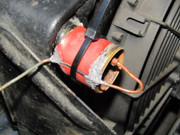
After 24 hours it was hope that the adhesive took hold and cut off the zip tie – whew, nothing moved. Then gently coax the hose end over the orange sleeve with lots of Permetex applied over the lead in the groove and at the two ends of the orange sleeve. Then to be doubly sure, I used two hose clamps, slightly offset, to provide a longer clamping surface on this end of the hose:
===>
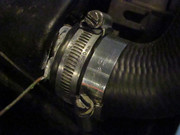
Leak tested, and both ends of the new hose remained nice and dry. But then there still was that second, very slow coolant seepage point. This one was much more concerning: the location was where the outboard bolt flange met the body of the thermostat housing. Nothing to do but partially drain the wretched cooling system once again and remove the thermostat housing to inspect its interior. After sanding off the gunk deposited on the interior surface near where the bolt flange was at the exterior of the housing, a small crack (blue arrow) showed up on the inside of the thermostat housing, double fig compote:
===>
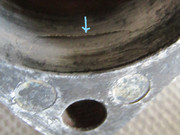
So the coolant was seeping right through the wall of the housing. I had a spare thermostat housing in hand, but it was old/used, physically totally sound, but as drab as a lump of coal. So I decided to see if I could repair my highly polished, leaking housing. I got a stick of “QuikAluminum” aluminum-reinforced epoxy putty from Polymeric Systems, which had glowing claims (I was dubious). I spread the putty over and beyond the extent of the interior crack. I also set another sample spread of putty aside on the table just to see how it cured. Within an hour, the sample had cured into a hard mass. I then waited a day and sanded down the putty that had been used for the interior crack patch for a smooth surface (at blue arrow):
===>
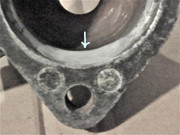
Now on to the really serious testing. For the first time in over two months (and after significant disassembly and reassembly), PFJ was requested to crank the engine. Three twists of the key, and PFJ sprang right back to life! Then it was three times through the published procedure to feed and bleed the cooling system, each with a three minute run of the engine. Then it was out to move around the driveway under power. Then it was repeated examinations under the bonnet for any dampness anywhere for a couple of days. PFJ remained bone dry. Looks like the 12-vane water pump adventure has concluded successfully. And PFJ has joined the other Blues Brother back in the sunshine:
===>

Onwards to the 17 other things I need to do to PFJ....